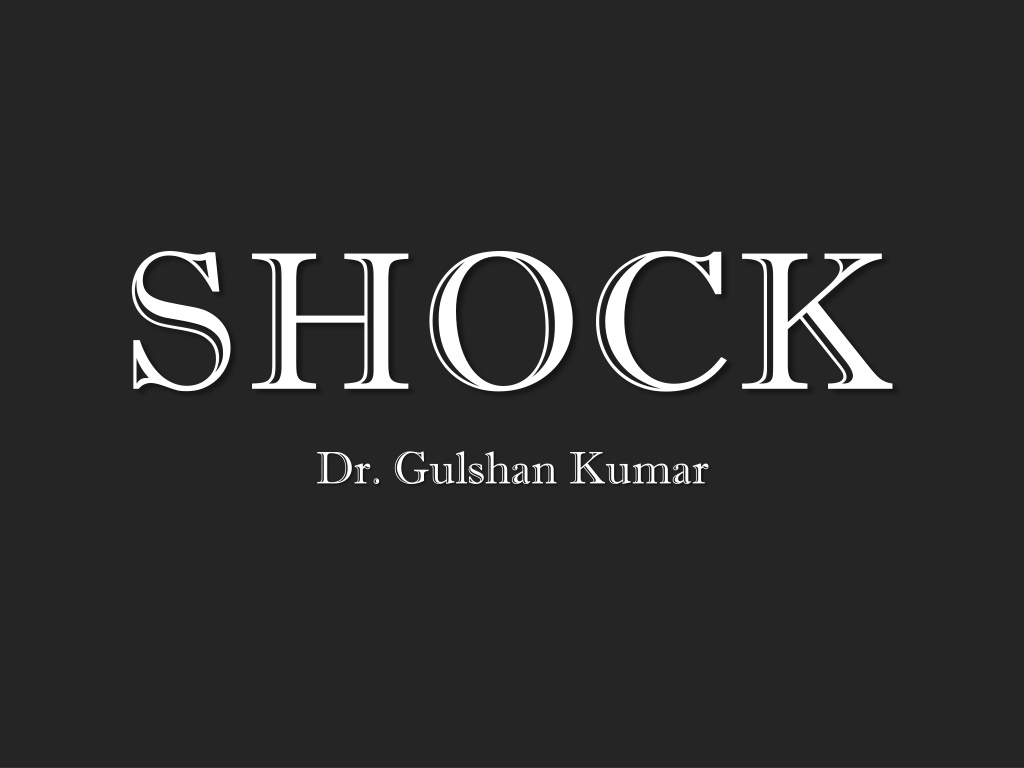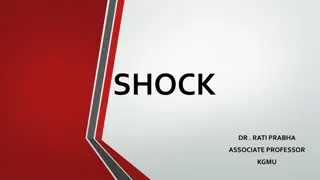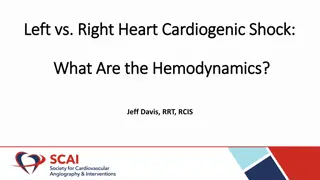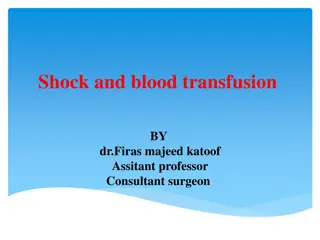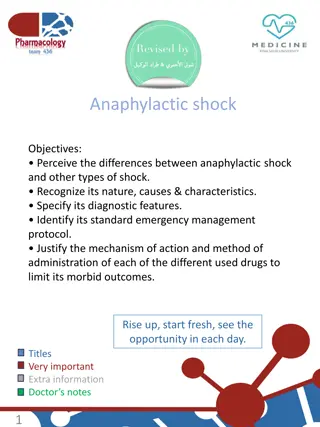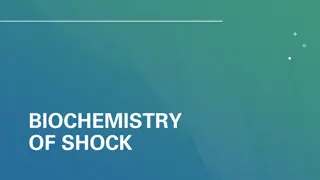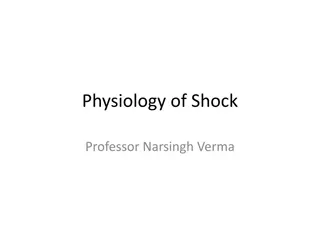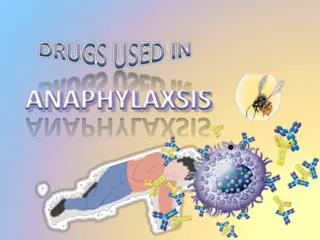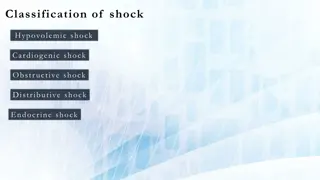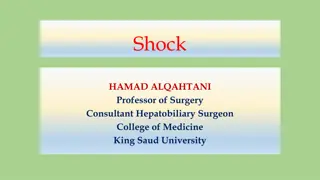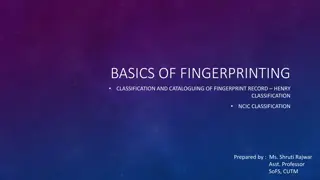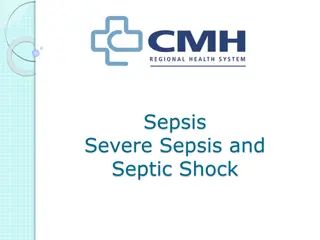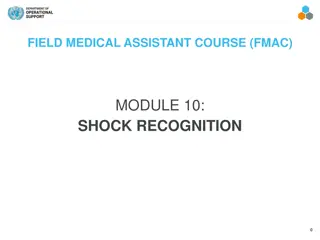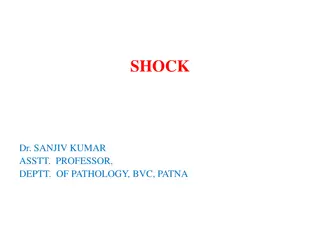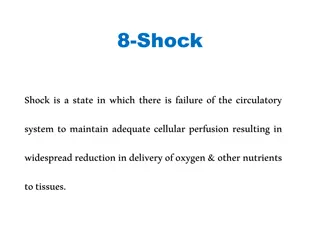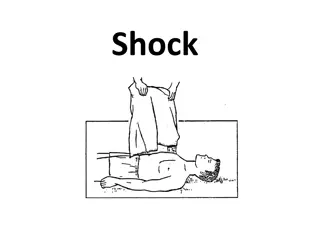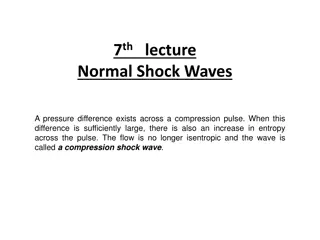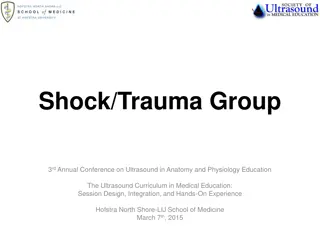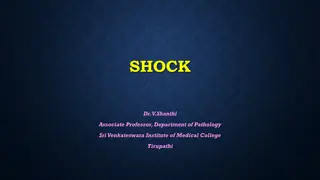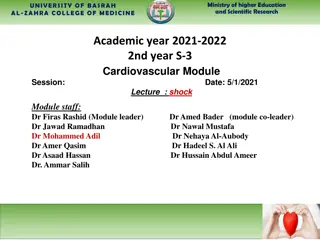Shock: Types, Causes, and Classification
Shock is a complex condition resulting from an imbalance between oxygen delivery and consumption in the body. It can be caused by various insults and classified into different types such as hypovolaemic, cardiogenic, obstructive, and distributive. Each type has specific causes and manifestations, contributing to a critical clinical syndrome requiring prompt intervention.
Download Presentation

Please find below an Image/Link to download the presentation.
The content on the website is provided AS IS for your information and personal use only. It may not be sold, licensed, or shared on other websites without obtaining consent from the author.If you encounter any issues during the download, it is possible that the publisher has removed the file from their server.
You are allowed to download the files provided on this website for personal or commercial use, subject to the condition that they are used lawfully. All files are the property of their respective owners.
The content on the website is provided AS IS for your information and personal use only. It may not be sold, licensed, or shared on other websites without obtaining consent from the author.
E N D
Presentation Transcript
SHOCK Dr. Gulshan Kumar
Shock Can be defined as An imbalance between oxygen delivery and oxygen consumption such that the delivery of oxygen does not meet the needs of the tissue. OR An acute clinical syndrome characterized by progressive circulatory inadequate capillary hypoxia. failure perfusion that and leads cellular to
Shock Shock is a complex, multisystem disorder that may be caused by a variety of insults.
Shock: Classification Hypovolaemic Haemorrhage Dehydration Diarrhoea & vomiting Hypoglycaemia Burns Third spacing Pleural /Peritoneal sac, (hydro-thorax/peritoneum) Fluid accumulation in GI proximal to obstruction
Shock: Classification Cardiogenic Myocardial infarction Valvular dysfunction Dysrrhythmia Cardiomyopathy (myocarditis, etc.)
Shock: Classification Obstructive Obstruction within the veins (Emboli etc.) Compression of the heart Pressure on the vessels
Shock: Classification Distributive (Vasogenic) Septic-vasodilation-permeable vessels G -ve dead cell wall inflammatory Chemicals- vasodilation-septic shock G +ve live cell wall-exotoxins antigens + inflammation- vasodilation-toxic shock Allergic: allergen*-mass interaction with antibodies on mast cells release histamines *Allergens: vaccines, antibiotics, NSAIDS, latex, etc. Hot/warm shock
Shock: Classification Distributive (Vasogenic) Neurogenic- Equillibrium disturbed Decreased sympathetic (mainly thoraco-lumbar T1-L3 nerves) out flow OR Increased parasympathetic (mainly cranial nerves) out flow
Shock: Classification Distributive (Vasogenic) Spinal Spinal injury mainly to thoracic spine Vasovagal syncope Vasodilatation + vagal outflow due to severe pain Systemic Inflammatory Response Syndrome
Shock: Stages Compensated stage Progressive stage Irreversible stage
Shock: Stages Compensated stage (non-progressive) Neurological response Endocrinal response (Neuro) Sympathetic Responses: Increased HR, peripheral vasoconstriction, increased CO and venous return
Shock: Stages Compensated stage (non-progressive) (Neuro) Sympathetic Responses: Decreased BP and increased CO2 sensed by baroceptors in the carotid sinus and aorta- impulses to medulla oblongata More sympathetic impulses and less para- sympathetic impulses Increased HR, peripheral vasoconstriction, increased Cardiac Output and venous return More RENIN and Adrenalin and nor Adrenalin
Shock: Stages Compensated stage (non-progressive) Endocrinal Responses- Adrenalin secretion just like sympathetic response JG complex in kidney sense falling BP-RENIN released Renin acts on circulating ANGIOTENSINOGEN (produced in liver) to form ANGIOTENSIN-I (10 amino acid protein) Some vasoconstriction + secretion of ALDOSTERONE from the adrenal cortex to retain Na++ in renal tubules. Retains water increases IV volume increased venous return hence Cardiac Output
Shock: Stages Compensated stage (non-progressive) Endocrinal Responses- Circulating ANGIOTENSIN-I reaches lungs where ACE (angiotensin converting enzyme )converts to ANGIOTENSIN-II by removing 2 amino acids ANGIOTENSIN-II more profound vasoconstriction increased peripheral resistance, veinular constriction-increased venous return- increased preload Even more ALDOSTERONE it also stimulates osmoreceptors in the hypothalamus-- THIRST
Shock: Stages Compensated stage (non-progressive) Endocrinal Responses- THIRST to drink more- increased fluid ADH (vasopressin) due to decreased B volume Increased reabsorption of water in kidneys +Vaso constriction
Shock: Stages Progressiv (Decompensated) stage Compensatory mechanisms are no longer working Progressive fall in BP Deleterious effects on vessels Overall condition deteriorates Increased hypoperfusion of the kidney, brain, GIT, myocardium, lungs, medulla oblongata Over some period of time the patient passes into stage of irreversible shock. Difficult to tell the difference Last window of opportunity to save the animal- aggressive therapy required- INTERVENE now
Shock: Stages Irreversible stage Irreversible changes in the animal s body The animal is still alive but because of irreversible damage progresses towards death Treat before it progresses to irreversible Preferably within an hour more likely to survive. The GOLDEN HOUR.
Shock: Management The first hour is crucial hence called the GOLDEN HOUR The single most important factor in a successful resuscitation from shock is time Rapid expeditious therapy in early therapy may lead to good results The basis of initial therapy is constituted by: A, B, C & D.
Shock: Management A : establish a patent airway and maintain it at all times Check for any obstruction in the airway Ensure a patent airway Most post-op patients have ET in place .
Shock: Management B : Check breathing Supplemental oxygen-@ 5L/minute by Facemask or a tube directed towards nostril/mouth If no ET try to place one so that Oxygen can be administered through anaesthesia machine. Administer respiratory stimulant if needed (Doxapram @ 1-2 mg/kg b.w.t., IV)
Shock: Management C : Check circulation- the cardiovascular system Control of haemorrhage (internal and external) Compression if necessary. As in CPR Defibrillator etc.
Shock: Management Vascular access Catheterise the peripheral veins namely the cephalic and saphenous (lateral in dog, medial in cat) In case of GDV never catheterise saphenous which is compromised Dilated stomach prevents adequate caudal venous return Catheterise more than one veins with large bore catheters. Try jugular . Later Venous cutdown in those with collapsed veins
Shock: Management Fluids Crystalloids replenish fluids effectively Eg. RL, Physiological saline, normosol, etc. Infusion rate of crystalloids: (50-100 mL/kg/hr) 90 mL/kg/hr in dogs 55 mL/kg/hr in cats The entire dose to be given in 10-15 minutes
Shock: Management Fluids But in due course of time: .. Dilution of proteins hence decreased oncotic pressure Promotes extravasation of fluids Brain/Lungs ..catastrophic due to oedema Hence to maintain fluids in circulation colloids are required 3 times more fluid is held by colloids as compared to crystalloids
Shock: Management Fluids Colloids are required Maintain fluid balance between intravascular and interstitial compartments. Biological colloids: blood, albumin, plasma Synthetic colloids: Hetastarch, oxyglobin, etc.
Shock: Management Fluids Whole blood not to exceed 22 mL/kg/hr Albumin 5% @ 10-20 mL/kg/hr Volume expansion and oncotic pr. Draw Na and water from interstitium Hetastarch @ 20 mL/kg in dog & 15 20 mL/kg in cat
Shock: Management Drugs After adequate fluid replenishment: Antagonise anaesthetics and preanaesthetics Adrenaline in anaphylactic shock (remove cause of allergy) Antihistamines in anaphylactic shock Inotrops Dopamine (vasopressor) @ 3-10 g/kg b.w.t., IV Calcium chloride soln. 10% @ 1ml/ 10 kg b.w.t., IV.
Shock: Management Drugs After adequate fluid replenishment: Antibiotics and corticosteroids in septic shock Potent analgesics for pain Antiarrhythmics lidocaine @ 2-4 mg/kg IV Propranolol @ 0.05 mg/kg b.w.t., IV Counter acidosis: Sodium bicarbonate saline 5% @ 3- 4 ml/kg b.w.t., IV (?????)
Shock: Management Drugs Glucocorticoids????????? Potent anti inflammatory agents, so have role in septic shock and perfusion injury suspicion in which inflammatory mediators are released from traumatized cells. After normalization of CVP, dexamethasone may be given @ 4mg-6mg/ kg b.w.t. Not given in hypovolemic shock as they cause peripheral vascular relaxation causing hypotension
Shock: Management Surgical removal of the cause (if any) eg. Bowel obstruction, abscess, crushed extremity, decompression or radical surgery. gangrene or
